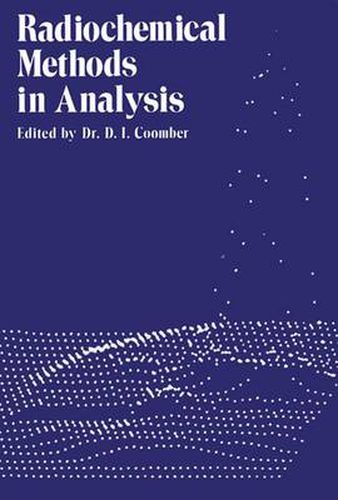Readings Newsletter
Become a Readings Member to make your shopping experience even easier.
Sign in or sign up for free!
You’re not far away from qualifying for FREE standard shipping within Australia
You’ve qualified for FREE standard shipping within Australia
The cart is loading…






This title is printed to order. This book may have been self-published. If so, we cannot guarantee the quality of the content. In the main most books will have gone through the editing process however some may not. We therefore suggest that you be aware of this before ordering this book. If in doubt check either the author or publisher’s details as we are unable to accept any returns unless they are faulty. Please contact us if you have any questions.
The aim of this book is to give an account of the principal radiochemical methods used in chemical analysis. It is assumed that the reader already has some background knowledge of radioactivity, available from several general textbooks. For this reason some subjects, e. g. the fundamentals of radio activity, the properties of radiation, statistics of counting procedures, the precautions needed in working with radioactive materials, which could have occupied half the text, are not considered in detail. The different aspects of radiochemical analysis have been covered by specialized books and reviews, e. g. on activation analysis, gamma spectrometry, radiometric titrations. A good deal of information is in the form of reports of meetings and symposia and liquid scintillation counting, for instance, has been mainly covered in this way. There are also a large number of journals. It is therefore hoped that this book will help fill the gap between the introductory texts and the specialized sources, many of which are referred to in the chapter references. The ftrst three chapters in the present volume deal with the methods of measurement of radioactive nuclides. Chapter I gives a general account of detection and measurement techniques. The next two chapters are devoted to two specialized techniques: gamma-ray spectrometry and liquid scintilla tion counting.
$9.00 standard shipping within Australia
FREE standard shipping within Australia for orders over $100.00
Express & International shipping calculated at checkout
This title is printed to order. This book may have been self-published. If so, we cannot guarantee the quality of the content. In the main most books will have gone through the editing process however some may not. We therefore suggest that you be aware of this before ordering this book. If in doubt check either the author or publisher’s details as we are unable to accept any returns unless they are faulty. Please contact us if you have any questions.
The aim of this book is to give an account of the principal radiochemical methods used in chemical analysis. It is assumed that the reader already has some background knowledge of radioactivity, available from several general textbooks. For this reason some subjects, e. g. the fundamentals of radio activity, the properties of radiation, statistics of counting procedures, the precautions needed in working with radioactive materials, which could have occupied half the text, are not considered in detail. The different aspects of radiochemical analysis have been covered by specialized books and reviews, e. g. on activation analysis, gamma spectrometry, radiometric titrations. A good deal of information is in the form of reports of meetings and symposia and liquid scintillation counting, for instance, has been mainly covered in this way. There are also a large number of journals. It is therefore hoped that this book will help fill the gap between the introductory texts and the specialized sources, many of which are referred to in the chapter references. The ftrst three chapters in the present volume deal with the methods of measurement of radioactive nuclides. Chapter I gives a general account of detection and measurement techniques. The next two chapters are devoted to two specialized techniques: gamma-ray spectrometry and liquid scintilla tion counting.